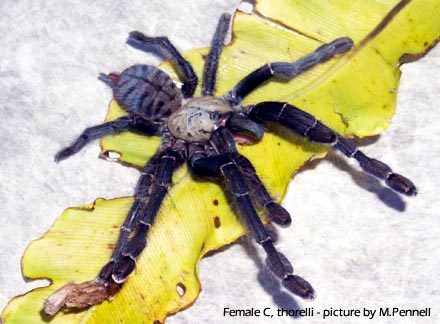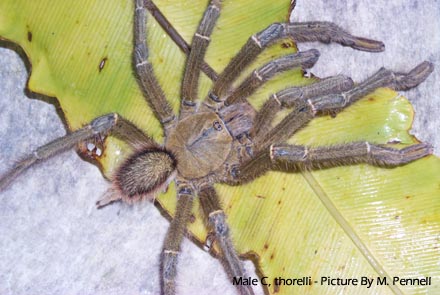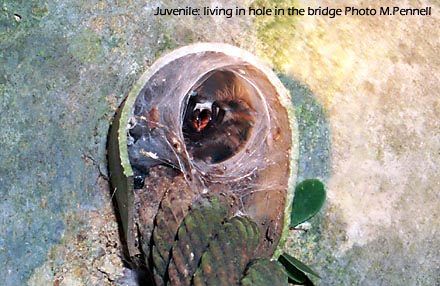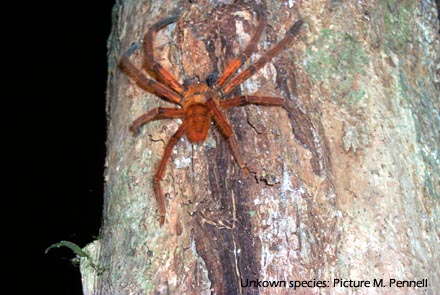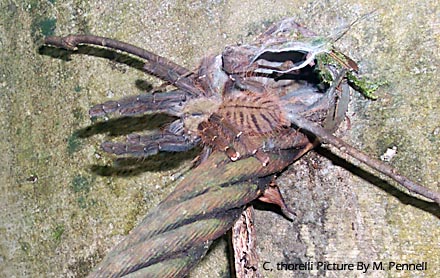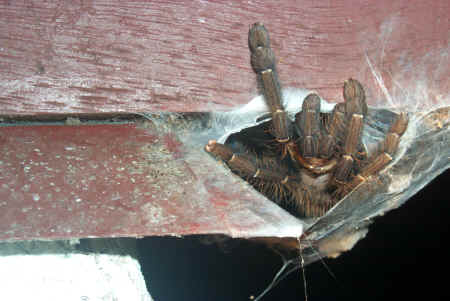|
Tree Spider of the
Hutan (Malaysian Rainforest) Observations in the wild of Cyriopagopus thorelli (Simon 1901) This large, Asian tarantula has been the talk of the spider world over the past few years, although it would seem that very little is actually known about its habitat and lifestyle. During the summer of 1999 I was fortunate enough to have observed one in the wild. Surprisingly, it was living in a hole some four feet from the ground up a supporting post of an old forest hut. I say surprisingly as up until that moment Cyriopagopus thorelli had been considered, by those in the know, to be purely terrestrial. Not long after I had returned from Malaysia in 1999, a few of these beautiful earth tigers made an appearance up at a show. They differed from the specimen of that I had already observed; they were very dark and did not have the bright hues of green and orange tiger stripes on the abdomen as did the one observed in situ in Malaysia. It would seem that this particular species of tarantula has many colour forms and darkens with age. Colours range from the deep blue and hues of bluish grey on the abdomen to the dark green with olive carapace and orange tiger striped abdomen. I would suggest that other colour forms may well exist. Reputedly these show specimens had been found living in old bamboo. Does this then point to an arboreal species? My hypothesis was still disputed by the establishment. It seemed I would need further proof if my theory were to be credible. Could it be that the different colour forms reflects the different life styles of this truly magnificent spider? As I was planning another trip in 2000, it would be a good time to find out! The Cameron Highlands are, it seems, devoid of tarantulas as it is far too high to find them. You have to travel back down the highway and way past a small town called Ringlet. Then, and only then, will you see signs of tarantula life? Well, so you would think! In truth the vast majority of the colonies along this road have been strip-mined and are gone. Only very small juveniles remained. Someone, somewhere, has hundreds of Coremiocnemis valida (formally validus) (Pocock, 1895). Our first signs of the elusive Earth Tiger came when a friend of our guest house owner told us that we indeed had to travel down lower, towards Tapah. On showing him the small photograph he replied enthusiastically, “Yes, this is the tree spider. That is what we call it.” A strange name for an “EARTH” Tiger!!! We followed this lead and went to where he told us we would find this tree spider. I hope that the reader will forgive me if I refrain from giving exact details here, as although we never managed to gain access to the colony, it was clear that they existed in large numbers. I have no wish to bring the destruction observed previously down upon this unsuspecting colony. Obviously we had no proof that this was actually Cyriopagopus thorelli, but the description we were given matched the darker form, the bluish version. We were told it inhabited the area as there were a large number of fruiting trees and this attracted lots of insects. It could be observed emerging onto the bark of the tree to feed on these. Later that day a few of the workers from the flower farms turned up and told us of a large spider that came out at night onto the netting that covered the flowers. It fed on the moths and other flying insects attracted by the lights used there. Although the photo was shown it was difficult to say whether it was our spider that they had seen or just a large “true spider”. When you are talking to locals with not much knowledge or interest in spiders, try to remember that to them they all look the same and often as not are treated the same. Flattened with a spade! They did however promise that they would try and catch us a specimen. After following many leads we had yet to see this beast in its lair but on our last day in the Highlands we had one brought to us. This was not our ideal scenario but it was a great opportunity nonetheless to photograph one of these rare tarantulas.
Shortly afterwards we left the Highlands and headed for Kenong Rimba State Park. It was not until we had entered Park that we would finally come face to face with this denizen of the jungle, the beast of the trees, “The Tree Spider of the Hutan”. On one of our many night walks with our trusty guide Appu we managed to find our first Cyriopagopus thorelli and we were treated to a spider that lived very much like an Avicularia species.
Shortly afterwards, and only three feet away from our first sighting, we found our second. This is shown in the picture, although in a man-made hole, it was living as an arboreal tarantula. The obvious conclusion is that they would frequent the trees and inhabit any available hollows within them. It was late, the rain began to fall and happy to have used up a great deal of film we decided that we would come back in the morning and search the ground and under growth to see if indeed burrows existed there too. A few steps later Dean, my now weary companion who was in front, had shone his torch up a hole in a tree and there, as large as you like, was a truly monstrous specimen. Luckily enough he had managed to get his camera out and photograph it disappearing into its lair.
In the dark, gloomy, damp rainforests it was difficult to see, but believe me, never had a smugger grin adorned the face of this explorer. Redemption! The tree was about thirty feet tall and the hole was a gaping slit five feet up from the forest floor. It was dry inside and tapered off to a fist-sized hole another few feet up. The split in the small tree was about six inches wide and fifteen inches high. We retired for the evening and after discussion we decided that if three specimens could be found in area of a few square feet then surely we would find a few burrows to prove once and for all this tarantulas chosen lifestyle was both terrestrial and arboreal. From first light until dusk we searched in vain; hands and knees covered in forest leaf litter and God knows what else. At the end of what seemed an eternity we had not found a single terrestrial specimen. Our thoughts turned to the large hole-dwelling monster in the tree. It was time to go fishing! Appu disappeared and minutes later returned with a large jungle cockroach. He tied it with string to a stick and dangled it over the hole in the tree. A quick peek inside revealed her sitting faced down, legs collected together, her demeanour being similar to that of the Poecilotheria. We wandered off to give her time to get over our intrusion.
On our return a large, red, furry hunting, spider had appeared on the tree trunk and it had its eye(s) on our cockroach. We took a few pictures of this strange looking spider before it ran up the tree. Another quick look up the tree hole and she was almost out. We moved the cockroach-fishing pole. Snap! She had taken our bait and disappeared up the hole, not to be seen again that night. Our observations on this specimen showed that she had not changed colour from the juveniles we had seen in the holes on the bridge, indeed if anything, under torch light, she was almost bright green. Her abdomen was shades of pale green and dark green/black dorsally and fading to pale green to red on the top. The tiger stripes on the abdomen were defined and black. At first light Mike headed of with his SLR camera on his own to try and catch her out. He returned silent, but why? We had spent the day trekking around the whole area searching and checking every hole in every tree. Nothing was found. One observation, and perhaps a significant one at that, was that the other holes we found were wet inside and the hole with the spider was dry. That night we returned to visit our charge again. I was the first there. What I was about to see was a real shock and completely unexpected. There in front of me was the adult female C. thorelli and six or more juveniles. As a mass of legs bolted up inside the tree, I stood there with a perplexed look on my face. Juveniles? We could not believe it. It then occurred to us why Mike had returned silent. That morning he had seen a mass of spiderlings but as he was alone he had chosen not to say anything. Well here is our tree spider living arboreally and communally. Sound familiar? Poecilotheria have been found in this communal setting. At this point the temptation to cut the tree down and get full photographic documentation was very tempting. Appu studied the tree and said it was probably dying and could be legally removed by him. We talked some more and to Appu’s delight we decided that it should remain undisturbed and in place. After all, we where there to observe, not to destroy or collect. This trip was for the adventure and fun, not for the glory. We had no wish to elevate ourselves onto a pedestal. We are just a few enthusiasts educating ourselves and having fun. Hopefully our work would be of use to someone in the future. All too soon our time had come to leave the park and make long hot trek back to the boat. Halfway back, we paused on the last rope bridge out of the park to watch a large monitor lizard in the stream below. It remained under the water and mud soon obscured our view. We turned and there in front us was a large silk mass with two sticks about twenty-four inches long in a cross shape. Could this be another specimen? Yet again, this spider was in the hole created to house the cable that supported the bridge. About, six feet up. With careful manipulation we managed to extract the spider and get a good look at the beast. It was of the same species and colour form that we observed further back in the park. This was again a large specimen and highly aggressive. Fully happy and with satisfied grins we trekked onward and to the river.
Summary: My thanks to Dean Hewlett and Mike Richardson for their friendship and help. To Appu, our guide, hotel owner and good friend, to Mother Nature and myself for believing. To Ray and Angela Hale, Martin Nicholas, Andrew M. Smith and not forgetting Kim, my wife, who yet again stamped my ticket and allowed me to scoot off enjoying myself while she stayed home.
Foot Note: The return 2001
Conclusions they are not to be found living in any other way other than arboreal, or we just can't find them. We did however find a a terrestrial living tarantula and this remains unidentified. See a few of this year expeditions
pictures on these two web sites Footnote of 28th January 2006; It is now considered that the above species is in fact C,schioedtei (Thorell, 1891). The above article was written and published in the BTS journal in 2000 and was based on current information available to us at the time.
|
